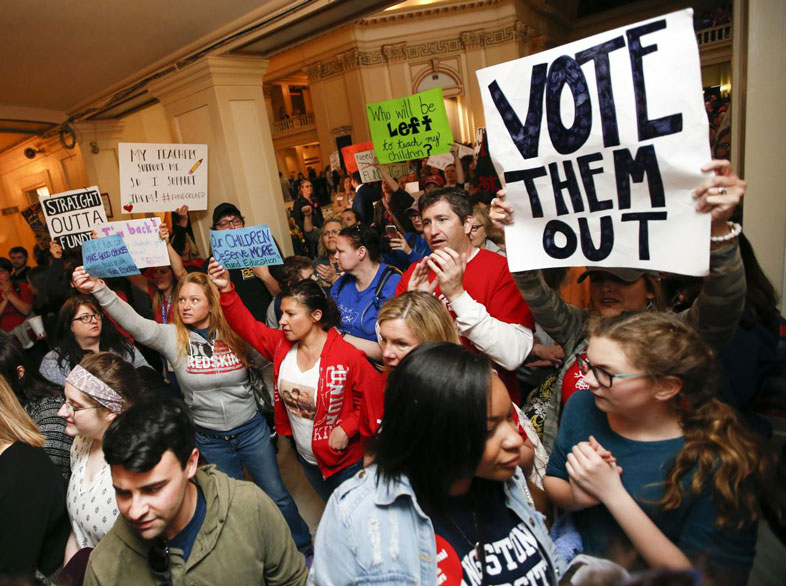As a growing number of teachers across the country hold strikes to advocate for better pay and increased education funding, new questions are arising about the power of teachers’ unions, the role of social media, and what teachers are doing to continue their efforts beyond large-scale work demonstrations.
During a May 16 panel at the Education Writers Association’s annual conference, speakers sought to contextualize the teacher actions, what they mean, and what’s next.
“All the movements going around the country, whether it be the ‘Me Too’ (movement) or the students from Parkland [suggest] the time is ripe in this country for activism … and teachers are getting involved,” said Ed Allen, the president of the Oklahoma City chapter of the American Federation of Teachers, during the Education Writers Association’s annual conference in Los Angeles.
“The walkout itself was the culmination of years of an assault on public education,” said Katie Endicott, a teacher at Mingo Central High School in Delbarton, W.Va., who participated in that state’s nine-day strike in February and March. “Enough was enough. We simply couldn’t take it anymore.”
Endicott said each state where teachers walked out this year – Oklahoma, West Virginia, Kentucky, Arizona, Colorado and North Carolina — has a unique set of circumstances that led to demonstrations by teachers.
History Lesson
Journalists should be mindful of each state’s specific history, she said, including previous efforts to increase teacher pay and what teachers did to advocate for raises before they walked out of school.
Chad Aldeman, a principal at Bellwether Education Partners, a Washington-based consulting firm, said reporters in other states should look at recent salary and school funding trends to see if those issues are causing unrest among local educators.
“Part of this is a healthy pushback on years of lack of funding in some states, and I think with the stagnant teacher salaries we are starting to see some change there,” said Aldeman, who works on teacher policy issues and writes for the Teacher Pensions Blog. He added that reporters should specifically look at whether the amount of money going to teachers and classrooms has remained the same, even if a state’s overall education budget has grown in recent years.
Teachers’ unions are often at the center of strikes and activism, but their role could be changing during an era of social media, which is important for journalists to watch, said Bartlett Cleland of the American Legislative Exchange Council, a membership organization for state lawmakers that advocates a free market and limited government approach.
“Teachers were able, despite what unions said, to organize themselves,” said Cleland, referring to the decision of some teachers in states like Oklahoma to continue a walkout despite the union’s call for it to end. “What happens if social media does become a force for regularly organizing teachers? What are the rules of unions to organize that force?”
Even in states where union leaders may not be talking about a pending teacher walkout, it’s worthwhile for reporters to observe the conversation among teachers on social media, which was the platform that helped launch strikes in multiple states.
“What we’ve learned is that unions don’t know how to talk to the folks on Facebook, and the folks on Facebook don’t know how to talk to unions,” said Allen of the Oklahoma city union, who added that pay raises and funding increases can be hard to negotiate on social media.
“Somehow unions have to figure out … how we blend the strengths of social media and the organizational skills of unions to make a bigger and stronger movement,” he said.
Unpacking Teacher Pay
While salaries are often at the heart of teacher walkouts, reporters should look beyond state pay rankings and averages, Aldeman said.
“We’re being deceived a little bit by the state teacher salary averages,” said Aldeman, who noted that the the average in many states is greatly influenced by a wave of younger teachers who bring the average down.
However, Allen and Endicott said it is important for reporters to dig deep into the true impact of low pay for teachers, asking questions about what classroom supplies teachers pay for out of their own pocket and the teacher pay disparity between districts in a state.
Support staff pay can also be an essential element of the story, and journalists should be mindful that these school employees, such as janitors and cafeteria workers, don’t get paid during a walkout that closes school, Allen said.
Even in states where teachers are not conducting strikes, educators are increasingly getting engaged in state politics, the panelists said.
Reporters can write about teacher groups visiting state capitols, as well as educators running for office or rallying around other candidates who share their education agenda.
“I had not been in the (West Virginia) Capitol since I was a page in the 10th grade,” said Endicott, age 32, who returned to the Capitol during her state’s teacher strike. “I walked in and then said, ‘Where do we go?’”
Endicott said many teachers were novices when it came to legislative advocacy, but by the end of the walkout they were experienced advocates who plan to continue putting pressure on lawmakers.
“After the walkout,” she said, “I felt so much more informed. Teachers are getting much more active in politics.”
